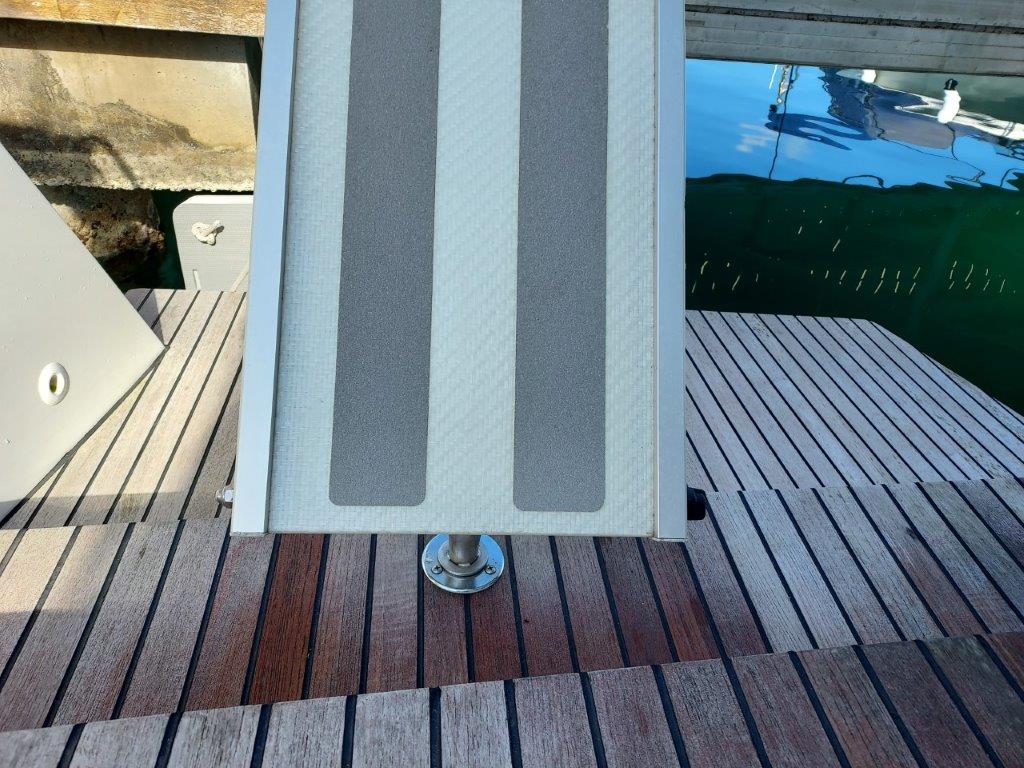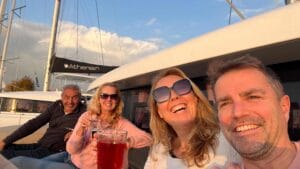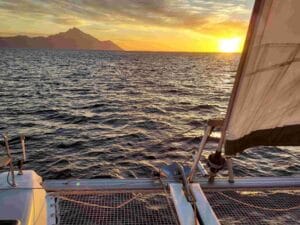If you are living and travelling with a sailboat, you know one thing for sure: there will be maintenance! The catamaran is our house and like a house, it needs maintenance as well. You sometimes can postpone maintenance for a house, but on a boat you can’t, because it’s a floating house and you don’t want to take the risk of it sinking 😊. Our boat is also our ‘car’, because we travel with it and you don’t want the ‘wheel’ to fall off while you are driving or the engine stopping in the middle of a storm because you didn’t do maintenance in time.
If you don’t do maintenance regularly, it will become repairs and most of the time, repairs announce themself precisely at a moment you didn’t want things to break down or stop working! In a harbor in Scotland, I read this witty slogan that was printed on the wall:
“If you don’t schedule time for maintenance, your equipment will schedule it for you”.
This is absolutely true! And if finally you are on schedule with all your to do’s for maintenance/upgrades or repairs, which is rarely the case by the way, there is ALWAYS cleaning to do on the boat! Outside or inside cleaning, because of all the salty water and living with open area’s, the boat needs cleaning regularly.
I call all this the Bermuda Triangle of sailing: you are always ‘suck’ into 1 of these 3: maintenance, repairs or cleaning. There is no escape of this ‘Bermuda Triangle’, it’s part of your lifestyle when you are a sailor.
So our boat often changes into a garage or workshop with tools and gear laying everywhere!

I like to inform you now about the maintenance/upgrades we have done to our boat in the last months. Here are our top 10 of maintenance:
1. Liferaft inspection
Every 3 years, you need to have your liferaft checked: does it still float and come out of it’s casing in times of crises (read: the catamaran sinking). The liferaft will inflate itself when touching the water, our liferaft has capacity for 8 people including emergency rations with water, etc.
For us, this 3 year deadline was there, when we were sailing along the coast of Portugal. So I checked online if our liferaftbrand Arimar had a dealer along the coast and there was one in Lisbon, called Aife.
I phoned them and asked them if we could make an appointment for the check somewhere the next 2 weeks when we would arrive in Lisbon and what the price would be. They had time for us and explained to us that this inspection could not be done on the boat itself (which was my assumption), but it had to be done in their service station base.
When we had arrived in Lisbon, a worker from the company came to our boat in the harbor to pick up the liferaft to bring it to their service station.

They did the check, for instance inflate the lifeboat, checking for damages, checking the lithium light that’s in the life raft, do cleaning, do a fillingtest for 24 hours, etc. They gave us a certificate valid for the next 3 years and they returned the liferaft again at the harbor and our boat.
2. Fire extinguishers check
When we talked to the life raft inspector (see nr 1), he also mentioned that it’s also good to have our life jackets checked as well (for an extra € 8 per jacket, they could do that check) and the fire extinguisher needed checking also.
The fire extinguisher check we could do this ourselves. We have 3 fire extinguishers on board (1 in the kitchen, 1 in our hull and 1 in the guests hull). We need to check if the marker was still pointing at the green zone, because then it had enough CO2 Bottle pressure when it is used in an emergency situation.

All three fire extinguishers were still in the green zone and we made a note to check the 3 of them every half year. These fire extinguishers have powder to spray around. In the future, we’d rather have fire extinguishers with foam, because powder when used could affect the electronics on the boat.
3. Dinghy outboard motor maintenance
For our dinghy, we use a Yamaha outboard motor (9.9 hp). This engine comes from a small boat that we owned. It’s an older engine (2003) and we noticed recently that the starting process not always worked and the engine generated more smoke than normal. So time for maintenance which was never done before by us and the previous owner(s) actually. Cycling around the harbor, we saw a Yamaha workshop, especially for maritime engines. They picked up our dinghy engine at the boat, for which we have a special transport cart.

They did a check and changed some of the older original factory parts and wrote everything down and returned the older parts in a bag, as proof to us. We again received a report with all the changes they made. This was in Portugal again and Portuguese are very much into registration and certification of materials, we were told and also have noticed ourselves.

4. Gas bottles refilled
When we left Holland to start our world trip, we bought an extra bottle of camping gas of 6 liters. The price was € 26, this was April 2021. When we passed the Netherlands again, sailing from England to Belgium in February 2022, we exchanged the gas tank. Now the price was € 46,95 for the same 6 liter bottle, which is quite a lot.
Now the first bottle was empty again and the extra bottle we bought, was half empty. In Spain, this Dutch type of a branded camping gas is hard to find. So we had to look for a company to do a refill.
On a sailor blog, we read that close to Albufeira, there was a company that refilled LPG bottles. So we went on our e-bikes with the 2 bottles with the capability of 6 liters and cycled for 45 minutes inland to this company. I called them upfront, because it was quite a journey, but they assured us they could do the job.
As you might begin noticing with our 4th maintenance case: maintenance takes time when you have a life of travelling. Because you don’t have all the spare parts in your ‘shed’ next to your house, or lots of do-it-yourself-shops around the corner in the city that you live in and you know of. We travel through different countries and we go to places we have not been before. For each special activity like maintenance, we have to do research and make efforts to get what we are looking for.
Here it turned out that the shop we cycled to, was a small car workshop, where also campervans filled up their gas bottles. And indeed, when we came there they refilled our gas bottles as well. But not with 6 liters, they filled it up to 12 liters each 😊. This was fine by us, different countries, different rules! And the price was € 1 per liter, so for € 18 we happily cycled back with our 2 camping gas bottles, filled to the brim.

5. Bridle bended
This is what sometimes happens when you anchor in a bay: if you let down your anchor with 20 to 40 meters of chain, you might pick up things that lay on the bottom 4 meters below you didn’t see. If it is seaweed or mud, it’s not that bad. But we have picked up a heavy chain of a big ship before and a few times we picked up fishing nets or in this case, lobster baskets that are on the bottom. All these things are heavy and also due to the current, the chain got quite twisted during the day and night.
We cut the ropes of these lobster baskets that got entangled in our anchor chain and threw the baskets back in the water (sorry, mr. Fisherman….).


In this case, it had turned our anchor chain so much, that it bended the bridle, which is the hook to your anchor chain. Now it didn’t work properly anymore. We had to buy an new one in a sailorshop.
6. Solar panel telescope tube got stuck
When we are at anchor, we need the energy of the solarpanels to have a comfortable living during the day using electricity (for example to cook, make coffee, keep the refrigerator cooled, charge the laptop battery, etc).
Gilles made the design for the RVS rack with solar panels that is in the back of the catamaran. You can adjust the angle of the panels to the position of the sun (in the morning or end of the afternoon for example). That’s done by turning the telescopic tubes. In 1 tube, the internal welt of the telescope mechanism was broken and therefore the telescope was not adjustable anymore. We needed a welder to fix this.

At that time we were in the city of Porto and in the harbor (Douro Marina) there was a small workshop for repairs. The welder had the time to do this and fixed the tube for us.
7. Cable sabotage
Vandalism happens all over the world. Also in the lifestyle of boating. When we came back to our boat, we noticed that an attempt was made (during the night?) to cut the long cable that attaches our subboard to the boat, our dinghy to the boat and keeps the dinghy engine under lock and key as well.

Maybe the cutters were disturbed during their activity, it looked like they had to stop or it took them too long, otherwise they might have stolen our subboard and dinghy including it’s outboard motor. We also found another cut in the cable (see at the right side of the thumb), this might have been their second attempt?
We hear sometimes of property getting stolen from ships or dinghy’s being stolen when people leave them at a jetty to go shopping or sightseeing. It’s a pity people do this.
In our case, we were lucky, nothing had been stolen. We bought another long cable and an extra second cable, both with a lock to make sure that thieves now need 2 attempts to get our stuff!
8. Generator with old gasoline
Usually our solar panels generate enough power when we are at anchor. However, if we are at anchor for more than 3 days, or like now during the spring, the days with sunhours are shorter or there are more clouds, we might not have collected enough kW during the day. In that case, we have to start our generator to keep our devices onboard working.
After 8 months of sailing, that moment came on a cloudy day at anchor. We started the generator, but it didn’t work. Gilles checked everything and it turned out the gasoline in the generator was old. We refreshed it.

However, after having used the generator a couple of times in a row, we were not quite pleased with how much (or how little!) it generated. So we decided to buy a new one (we bought our generator secondhand in 2019 at an auction for € 150).
In Marbella we found a small generator in a construction market which had a capacity of 3000watt at a fair price. The harbor was 20 minutes away by e-bike and the store did not deliver within 3 days and charged € 50 for that. So we had to find a solution to get the generator to the harbor. Gilles put the generator on his e-step and made a ‘test drive’. That went ok, so we drove back to the harbor this way 🙂

We have used the generator now once at the catamaran at anchor in a bay and it works perfectly!
9. Installing a gangway
When we left for our worldtrip in Mai 2021, we had bought a gangway (or passerelle in French), in case there was too much space between the boat and the quay to come ashore. We didn’t have to use it, until recently. Because in the Mediterranean sea, the way to get a place in the harbor, is not by tying up your boat to a jetty with your own lines. You have to use the mooring lines of the harbor that are attached to the quay and on the bottom. I’ve written about this Mediterranean mooring before: it’s to save space in popular harbors because more boats lay more closely next to each other, only separated with fenders in stead of jetties.
One disadvantage of this mooring technique, is that space between the back of your boat and the quay might be just too large to step ashore. Because you leave a bit of safe space between the boat and the concrete quay in case of swell or boats passing by and pushing your boat back to the quay.
Now it became time to install the gangway. Gilles drilled a hole in one of the steps at the back of our boat to install a sleeve where the pin of the gangway goes into. So that holds the gangway in place between the boat and the quay and is safe to walk over it.

We have used it now about 5 times and it’s a safe and comfortable way of getting ashore, certainly if you want to bring your bikes from the boat to land!

10. Rigging check
A recent maintenance we did, was the 2 year check of the rigging that holds the 22 meter mast in place. The last time it was done, was in March 2021 just before we left the Netherlands. So we had to do it again around February 2023.
This checking must be done because of the insurance policy we have. In case of an accident (hard wind or storm, a collision with another boat) and the masts breaks, the insurance company will check if there was the right tension on the rigging system. Otherwise they could blame the mast breaking due to lack of maintenance by the owners of the ship.
We had this check done by an official Lagoon dealer in Spain. I called a company called KAT marina, they had 4 locations at the Costa Blanca area where we were in February. They had a rigger available for us who worked with Lagoon42 riggingsystems before.
He came with his colleague to our boat in Torrevieja. The check took 2 hours, they measured the tension at the different heights of the rigging system.

The rigger went all the way up the mast. He had good news, the rigging was ok, only the line of our main sail had been shaved a bit at the top and needed to be replaced with 1 meter of new line. So the next day, the rigger returned for 1 hour and replaced the line. We received a certificate of the rigging check and are good to go for the next 2 years!








